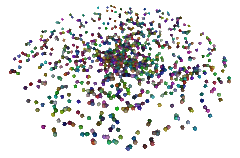Another tutorial, random points on a sphere
covers material that is very similiar to this web page. It is recommended
you review that material.
Being able to generate random points that are distributed across a disk,
or part of a disk, can be helpful when trying to portray a variety of
phenomena - spiral arms of hurricanes, galaxies and catherine-wheel
firework displays.
The first step is to generate a number of vectors in a square - well
actually, a cube of zero thickness!
float xyz[3]; /* generate random points */ for(n = 0; n < 1000; n++) { xyz[0] = randBetween(-1, 1); /* x */ xyz[1] = 0; /* y */ xyz[2] = randBetween(-1, 1); /* z */ /* use xyz in some way, then generate another point */ }
Next we constrain the random vectors to lie on the rim of a disk?

Download the source code
Download the RIB file



